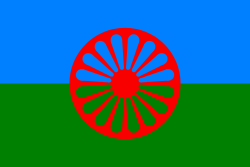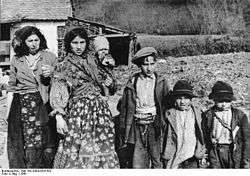Romani people in Croatia
 | |
|
Romani women wearing traditional dresses and their children near Zagreb in 1941 | |
| Total population | |
|---|---|
|
(16,675 (2011 census)[1] 30,000 to 40,000 (estimates)[2][3][4]) | |
| Languages | |
| Romani and Croatian | |
| Religion | |
|
Roman Catholicism Sunni Islam Eastern Orthodoxy[5] | |
| Related ethnic groups | |
| Roma in Bosnia and Herzegovina, Roma in Serbia and Roma in Hungary |

There have been Romani people in Croatia for more than 600 years and they are concentrated mostly in the northern regions of the country. The 2011 Croatian census found 16,675 Romani in Croatia or 0.4% of the population.[1] In 2001, more than half of the Romani population was located in the Međimurje County and the City of Zagreb.[6][7] Various estimates place the actual Romani population at 30,000-40,000,[2][3][4] with some up to 60,000.[2] A considerable number of Romani refugees in Croatia from the ethnic conflict in Bosnia.[8]
In the 2011 census, the largest religious groups among the Romani were Catholics (8,299 or 49.77% of them), Muslims (5,039 or 30.22% of them) and Eastern Orthodoxy (2,381 or 14.02% of them).[9]
There are more than 120 Romani minority NGOs in Croatia.[10] One of the most prominent is Croatian Roma Union.
History
Origin
The Romani people originate from Northern India,[11][12][13][14][15][16] presumably from the northwestern Indian states Rajasthan[15][16] and Punjab.[15]
The linguistic evidence has indisputably shown that roots of Romani language lie in India: the language has grammatical characteristics of Indian languages and shares with them a big part of the basic lexicon, for example, body parts or daily routines.[17]
More exactly, Romani shares the basic lexicon with Hindi and Punjabi. It shares many phonetic features with Marwari, while its grammar is closest to Bengali.[18]
Genetic findings in 2012 suggest the Romani originated in northwestern India and migrated as a group.[12][13][19] According to a genetic study in 2012, the ancestors of present scheduled tribes and scheduled caste populations of northern India, traditionally referred to collectively as the Ḍoma, are the likely ancestral populations of the modern European Roma.[20]
In February 2016, during the International Roma Conference, the Indian Minister of External Affairs stated that the people of the Roma community were children of India. The conference ended with a recommendation to the Government of India to recognize the Roma community spread across 30 countries as a part of the Indian diaspora.[21]
Migration to Croatia
Romani people were first time mentioned in Republic of Ragusa in 1362 in some commercial records.[8] Ten years later, Romani are mentioned in Zagreb, where they were merchants, tailors and butchers.[8]
Various Romani groups have lived in Croatia since the 14th century.[4]
In the Middle Ages Romani were part of cities population and they lived together with rest of population. According to litteras promotorias, nomad Romani groups also get privilege to resolve independently all intragroup conflicts.[22]
Maria Theresa and Joseph II with their regulations from 1761, 1767 and 1783 forbade Romani nomadic lifestyle, forced them to accept a local clothing code and language, made state regulations on personal and family names and they limited their choice of profession.[22]
Large groups of Romani arrived in Croatia in the 19th century from Romania after abolition of Romani slavery in 1855.[22]
World War II
Many Croatian Romani, as well as members of other minority groups like Serbs and Jews, were murdered by the ustasha during World War II.[23]
Culture
Language
Three groups of dialects of Romani language present in wider region are Carpathian Romani, Balkan Romani and Vlax Romani language.
Religion
In the 2011 census, the largest religious groups among the Romani were Catholics (8,299 or 49.77% of them), Muslims (5,039 or 30.22% of them) and Eastern Orthodoxy (2,381 or 14.02% of them).[9]
Romani in modern Croatia
In the Republic of Croatia, Romani have remained largely marginalized, so the government has a programme to provide them with systematic assistance in order to improve their living conditions and to include them in the social life.[3][4] According to a survey conducted in 1998, 70% of surveyed families at the time did not have permanently employed family member, 21% had one member, and 6% had two permanently employed members.[5] An additional risk is poor housing conditions, inadequate water supply and electricity infrastructure in Romani settlements, poor health care and low average level of education.[5]
In the Croatian parliamentary election, 2007, the Romani minority elected their first dedicated member of Croatian Parliament. In 2010, Romani were added to the preamble of the Croatian Constitution and thereby recognized as one of the autochthonous national minorities.[24] They elect a special representative to the Croatian Parliament shared with members of eleven other national minorities.[25] Since 2012 Faculty of Humanities and Social Sciences, University of Zagreb introduced for the first time courses Romani language I and Literature and culture of Roma.[26]
Romani in Međimurje County
According to estimates and available data, at the beginning of 2009 in Međimurje County lived about 5,500 Romani, which makes 4.7% of total population that made them largest national minority in county.[27] According to Census 2011, 2,887 people (2.44%) declared themselves as Romani.[6] Difference between Census and the actual situation can be explained by avoidance of Romani to declare their minority affiliation due to stigmatization. As example of this situation can be seen Donja Dubrava municipality that according to 2001 census didn't have a single member of Romani minority although at that time in municipality there were little Romani settlement with about 70 people (that no longer exists).[27]
Altogether there are twelve settlements in Medjimurje with Romani minority. Concentration of Romani in some settlements, and is some cases in certain peripheral streets of some settlements and very small number of Romani in other settlements show territorial segregation of Romani in county.[27] In more than half of Međimurje municipalities Romani are not present or are present in very small number.[27]
References
- 1 2 "Stanovništvo prema narodnosti, popisi 1971. - 2011." (in Croatian). Retrieved 21 December 2012.
- 1 2 3 Minority Rights Group International (July 2008). "World Directory of Minorities and Indigenous Peoples - Croatia : Roma". United Nations High Commissioner for Refugees. Retrieved 2011-11-04.
- 1 2 3 Office of National Minorities (2008-02-14). "Introduction". National programme for Roma. Croatian Government. Retrieved 2011-11-04.
- 1 2 3 4 Office of National Minorities (2008-02-14). "Characteristics of Roma in the Republic of Croatia". National programme for Roma. Croatian Government. Retrieved 2011-11-04.
- 1 2 3 Štambuk, Maja (June 2000). "Romi u Hrvatskoj devedesetih". Društvena istraživanja (in Croatian). Zagreb. 8 (2-3). Retrieved 2013-04-28.
- 1 2 "Population by ethnicity". Census. Croatian Bureau of Statistics. 2001. Retrieved 2011-11-04.
- ↑ "Status romske populacije u Republici Hrvatskoj". klinika.pravo.unizg.hr (in Croatian). Faculty of Law, University of Zagreb. 7 November 2011. Retrieved 31 May 2012.
- 1 2 3 "Ured vlade za nacionalne manjine-Obilježja Roma u RH". Retrieved 2013-03-09.
- 1 2 "4. Population by ethnicity and religion". Census of Population, Households and Dwellings 2011. Croatian Bureau of Statistics. Retrieved 2012-12-17.
- ↑ "Ured za ljudska prava i prava nacionalnihmanjina-Romi". Ured za ljudska prava i prava nacionalnihmanjina. Retrieved 2013-04-27.
- ↑ Hancock 2002, p. xx: ‘While a nine century removal from India has diluted Indian biological connection to the extent that for some Romanian groups, it may be hardly representative today, Sarren (1976:72) concluded that we still remain together, genetically, Asian rather than European’
- 1 2 Mendizabal, Isabel (6 December 2012). "Reconstructing the Population History of European Romani from Genome-wide Data". Current Biology. Retrieved 12 December 2012.
- 1 2 Sindya N. Bhanoo (11 December 2012). "Genomic Study Traces Roma to Northern India". New York Times.
- ↑ Current Biology.
- 1 2 3 K. Meira Goldberg; Ninotchka Devorah Bennahum; Michelle Heffner Hayes. "Flamenco on the Global Stage: Historical, Critical and Theoretical Perspectives". Books.google.ca. p. 50. Retrieved 2016-05-21.
- 1 2 Simon Broughton; Mark Ellingham; Richard Trillo. "World Music: Africa, Europe and the Middle East". Books.google.ca. p. 147. Retrieved 2016-05-21.
- ↑ Šebková, Hana; Žlnayová, Edita (1998), Nástin mluvnice slovenské romštiny (pro pedagogické účely) (PDF), Ústí nad Labem: Pedagogická fakulta Univerzity J. E. Purkyně v Ústí nad Labem, p. 4, ISBN 80-7044-205-0
- ↑ Hübschmannová, Milena (1995). "Romaňi čhib – romština: Několik základních informací o romském jazyku". Bulletin Muzea romské kultury. Brno: Muzeum romské kultury (4/1995).
Zatímco romská lexika je bližší hindštině, marvárštině, pandžábštině atd., v gramatické sféře nacházíme mnoho shod s východoindickým jazykem, s bengálštinou.
- ↑ "5 Intriguing Facts About the Roma". Live Science.
- ↑ Rai, N; Chaubey, G; Tamang, R; Pathak, AK; Singh, VK (2012), "The Phylogeography of Y-Chromosome Haplogroup H1a1a-M82 Reveals the Likely Indian Origin of the European Romani Populations", PLoS ONE, 7 (11): e48477, doi:10.1371/journal.pone.0048477
- ↑ "Can Romas be part of Indian diaspora?". khaleejtimes.com. 29 February 2016. Retrieved 4 March 2016.
- 1 2 3 Hrvatić, Neven (December 2004). "Romi u Hrvatskoj: od migracija do interkulturalnih odnosa". Migracijske i etničke teme (in Croatian). Zagreb. 20 (4). Retrieved 2013-04-28.
- ↑ Kenrick, Donald (2006). The Gypsies During the Second World War: The final chapter. The Gypsies During the Second World War. 3. Centre de recherches tsiganes (Université René Descartes) (illustrated ed.). Univ of Hertfordshire Press. p. 92. ISBN 978-1-902806-49-5. Retrieved 2011-11-28.
- ↑ Marijan Lipovac (2011-04-11). "Integracija Roma" [Integration of Roma]. Vjesnik (in Croatian). Archived from the original on 14 June 2012. Retrieved 2011-11-04.
- ↑ "Pravo pripadnika nacionalnih manjina u Republici Hrvatskoj na zastupljenost u Hrvatskom saboru". Zakon o izborima zastupnika u Hrvatski sabor (in Croatian). Croatian Parliament. Retrieved 2011-12-29.
- ↑ "Kolegiji Romski jezik I i Književnost i kultura Roma I". Retrieved 2013-04-27.
- 1 2 3 4 Šlezak, Hrvoje (December 2009). "Prostorna segregacija romskog stanovništva u Međimurskoj županiji". Hrvatski geografski glasnik (in Croatian). Zagreb. 71 (2). Retrieved 2013-04-27.
External links
| Wikimedia Commons has media related to Roma people in Croatia. |
- The UN Refugee Agency - Chronology for Roma in Croatia
- Government Policies and Programs to Eliminate the Worst Forms of Child Labor

